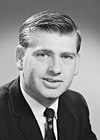Division of Griffith
| Griffith Australian House of Representatives Division | |
|---|---|
Map Interactive map of boundaries | |
| Created | 1934 |
| MP | Max Chandler-Mather |
| Party | Greens |
| Namesake | Sir Samuel Griffith |
| Electors | 121,277 (2022) |
| Area | 57 km2 (22.0 sq mi) |
| Demographic | Inner metropolitan |
The Division of Griffith is an electoral division for the Australian House of Representatives. The division covers the inner southern suburbs of Brisbane, Queensland.[1]
History
[edit]
The division is named after Sir Samuel Griffith, former politician and a principal author of the Constitution of Australia.[1]
Griffith was created in 1934, replacing the seat of Oxley which had been established in 1900.[2]
Historically, the seat has been highly marginal and has alternated between the Labor Party and Liberal Party . The 1939 Griffith by-election was nearly the sight of an upset, with the UAP/Country coalition government coming within five votes of taking the seat from the incumbent opposition Labor party. Apart from 1920, the rare feat of a Government winning a seat from the Opposition in a by-election would only be achieved in 2023 when Labor won the 2023 Aston by-election.
Close contests ensued, with the seat being decided by just 118 votes in 1954, 21 votes in 1958, and 182 votes in 1972. In 1977, the seat was won by future Hawke-Keating government minister Ben Humphreys under whose nearly 20-year tenure the seat became much safer for Labor. However, on Humphreys' retirement and as Labor lost government in 1996, future Prime Minister Kevin Rudd failed to win the seat to the Liberal Party's Graeme McDougall by 1.5%. Rudd would later emerge victorious in 1998, winning the seat with 52.4% of the two-candidate-preferred vote. Rudd steadily increased his margin at each successive election until 2010, reaching a peak of 62.3% of the vote in 2007 as he led Labor to government. Rudd suffered an under average two-party-preferred swing in 2010 having been deposed as Prime Minister two months earlier, perhaps a reflection of sympathy to his removal from voters.
Rudd suffered a further swing against him in 2013 with the seat becoming marginal once more. He retired following the election and bequeathed a 3% margin to his successor Terri Butler who narrowly retained the seat at the ensuing 2014 Griffith by-election with a 1.8% margin, 1.6% in 2016, and 2.9% in 2019 – one of the few swings to Labor in Queensland. However, during Butler's tenure, Labor's primary vote saw itself become cannibalized to its left flank, with the Greens winning five booths on primary votes at the 2019 federal election with a further four booths in which the party came at a close second. The Greens also achieved their strongest favourable swing in 2019 within this seat (at 6.67%). In 2020, the Greens won the state seat of South Brisbane from Labor, which overlaps with part of the electorate, further supporting the trend of a growing Greens vote that has reduced Labor's primary vote in the seat. This subsequently led to Greens candidate Max Chandler-Mather winning the seat in the 2022 federal election, with 60.5% of the two-party preferred vote and 34.6% of the first preference vote, Labor being pushed into third place.[3]
Boundaries
[edit]Since 1984, federal electoral division boundaries in Australia have been determined at redistributions by a redistribution committee appointed by the Australian Electoral Commission. Redistributions occur for the boundaries of divisions in a particular state, and they occur every seven years, or sooner if a state's representation entitlement changes or when divisions of a state are malapportioned.[4]
Griffith covers the inner southern Brisbane suburbs of Balmoral, Bulimba, Camp Hill, Carina Heights, Coorparoo, Dutton Park, East Brisbane, Greenslopes, Highgate Hill, Hawthorne, Kangaroo Point, Morningside, Norman Park, Seven Hills, South Brisbane, Stones Corner, West End and Woolloongabba, as well as parts of Annerley, Cannon Hill, Carina, Holland Park, Holland Park West, Mount Gravatt East, Murarrie, and Tarragindi.[1]
Members
[edit]Election results
[edit]| Party | Candidate | Votes | % | ±% | |
|---|---|---|---|---|---|
| Greens | Max Chandler-Mather | 36,771 | 34.59 | +10.94 | |
| Liberal National | Olivia Roberts | 32,685 | 30.74 | −10.23 | |
| Labor | Terri Butler | 30,769 | 28.94 | −2.01 | |
| One Nation | Shari Ware | 3,504 | 3.30 | +1.18 | |
| United Australia | Robert McMullan | 2,581 | 2.43 | +0.98 | |
| Total formal votes | 106,310 | 98.00 | +0.26 | ||
| Informal votes | 2,169 | 2.00 | −0.26 | ||
| Turnout | 108,479 | 89.45 | −1.60 | ||
| Notional two-party-preferred count | |||||
| Labor | Terri Butler | 64,923 | 61.07 | +8.21 | |
| Liberal National | Olivia Roberts | 41,387 | 38.93 | −8.21 | |
| Two-candidate-preferred result | |||||
| Greens | Max Chandler-Mather | 64,271 | 60.46 | +60.46 | |
| Liberal National | Olivia Roberts | 42,039 | 39.54 | −7.59 | |
| Greens gain from Labor | |||||
Graphs are unavailable due to technical issues. There is more info on Phabricator and on MediaWiki.org. |
Graphs are unavailable due to technical issues. There is more info on Phabricator and on MediaWiki.org. |
References
[edit]- ^ a b c "Profile of the electoral division of Griffith (Qld)". Australian Electoral Commission. Retrieved 20 January 2014.
- ^ "Commonwealth Electoral Division of Oxley (Qld)". Australian Electoral Commission. Retrieved 20 January 2014.
- ^ "Griffith (Key Seat) - Federal Electorate, Candidates, Results". abc.net.au. Retrieved 25 January 2023.
- ^ Muller, Damon (14 November 2017). "The process of federal redistributions: a quick guide". Parliament of Australia. Retrieved 19 April 2022.
- ^ Griffith, QLD, 2022 Tally Room, Australian Electoral Commission.













